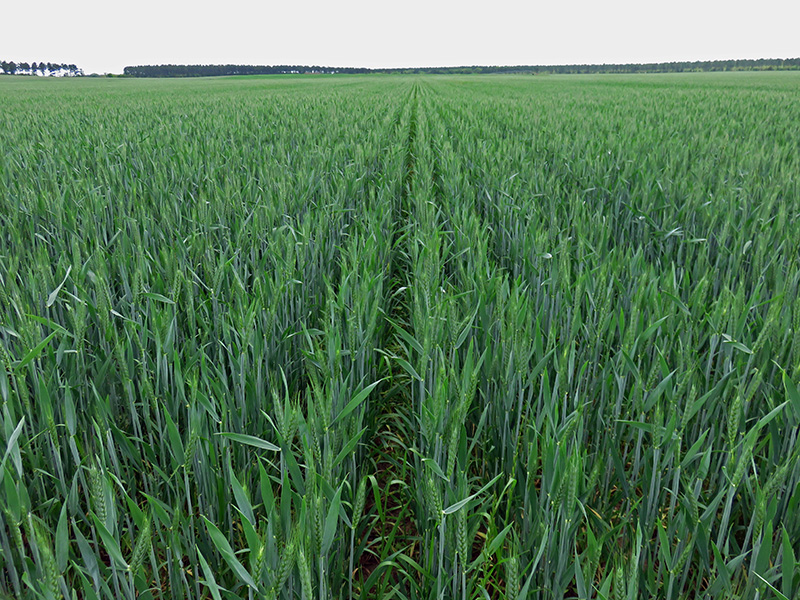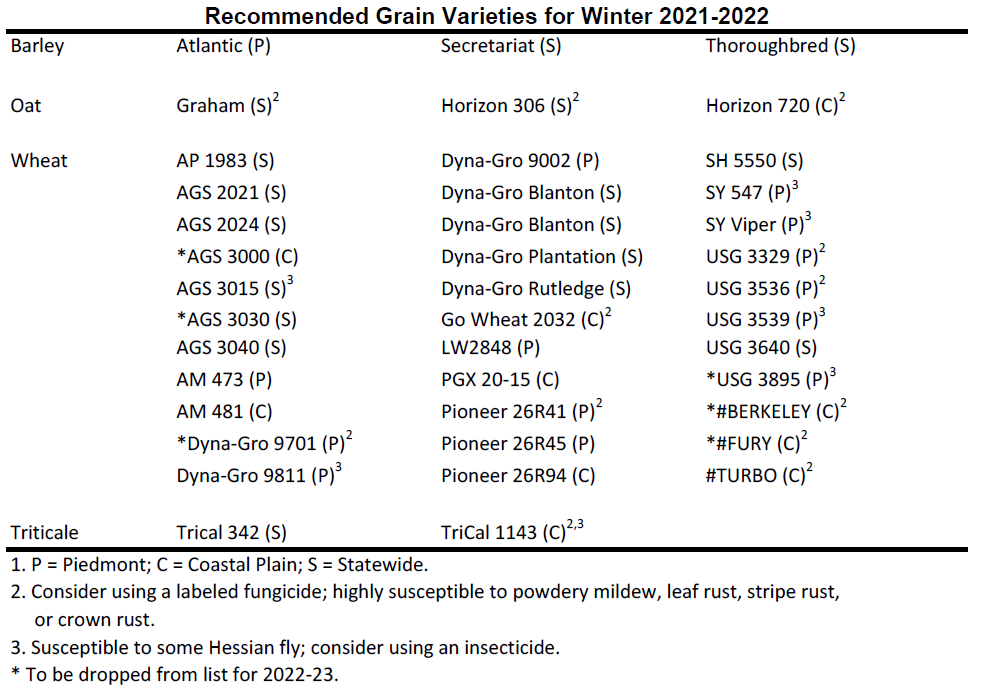Rome Ethredge, Interim UGA Grains and Soybean Agronomist, and Dewey Lee, Professor-retired, University of Georgia
Wheat can be an excellent off-season crop to supplement income for row crop farms. It can also provide the numerous conservation benefits of having a winter cover crop, while also adding to the healthy rotation of a diverse crop farm. The following are 10 key areas of management that can boost the yield and productivity of your winter wheat crop.
–
1). Use deep tillage to disrupt hard pans
Wheat responds well to deep tillage when hard pans are present in our soils, particularly sandy soils. Prepare soils for planting by first tilling with a V-ripper, chisel plow, paraplow or subsoiler. Firm the seed bed with a cultipacker or small, light disk to reduce deep ruts from planting. Till the soil only to a depth necessary to break the hard pan. Simple disking is not as effective as deep tillage but it is preferred over no-tilling wheat. No-till wheat can be productive (mostly on heavy, clayey soils) but the yields, in general, are 5 to 25 bushels per acre less than conventionally tilled wheat.
–
2). Plant high yielding, pest resistant, well adapted varieties
Yield data for all the recommended varieties for Georgia are found in the current Georgia Wheat Production Guide or Georgia Small Grain Variety Performance Test Bulletin. Be sure to note each of the variety characteristics of the variety you choose such as vernalization, maturity, lodging resistance, pest resistance, so as to manage each variety properly for highest yield. Check with your local county Extension Office for the latest information on recommended varieties. While some may perform to satisfactory levels, others have characteristics that may be too difficult to overcome with good management.
3). Plant the appropriate seeding rate for your planting method
Wheat can be successfully established by either drilling or broadcasting the seed and incorporating into the soil to a shallow depth of 1 to 1.5 inches. In general, drilling wheat yields 7 to 8% more yield. If incorporation of broadcast seed is poor, then yield differences are even greater. In a drill, plant 22 to 25 seeds per row foot (7.5- inch drill width). This is equivalent to approximately 35- 40 seeds per square foot. Use 10 to 15% more seed when planting after the recommended planting window. When broadcasting the seed, calibrate the equipment to plant 40 seeds per square foot. If broadcasting, be careful in covering seed. Disk harrows can easily bury seed too deeply, and vertical tillage can leave seed on top of the ground. Field cultivators provide shallow incorporation and are more dependable in depth. When possible, always use high quality, certified seed and save a tag of each separate lot for good record keeping. Remember, bin-run seed can present more of a problem with contamination, loss of germination and/or mix up in varieties. Also be aware that fungicide seed treatments are helpful during warm, wet fall temperatures. See the Small Grain Chapter of the UGA Pest Control Handbook for labeled treatments and rates.
–
4). Plant during your recommended planting period
The recommended planting dates for Georgia are the seven days prior to and after the five-year average first frost day for your farm. Varieties with long vernalization requirements should be planted in the first seven to ten days prior to the first frost day. Extremely early varieties with short vernalization requirements must be planted in the very last days of the recommended window. These varieties will suffer winter injury if planted too early as they would enter the jointing phase (Zadoks GS 32) prior to the time that sub-freezing temperatures generally do not occur.
–
5). Scout fields for early insect infestations and control potentially damaging insects
Hessian fly and aphids are the two insects generally causing yield loss in the fall. Control insects by either planting resistant varieties and or using an approved insecticide. Protect wheat from Hessian fly by planting resistant varieties or treating seed either with Cruiser® (thiamethoxam), NipsIt Inside® (clothianidin) or a brand of imidacloprid. See the Small Grain Chapter of the UGA Pest Control Handbook for labeled treatments and rates.
These seed treatments are also effective against aphids. Aphids vector the Barley yellow dwarf virus and it is important to protect wheat from this virus. For both insects, scout wheat fields 25 to 35 days after emergence for the presence of either aphids or Hessian fly. Apply a foliar approved pyrethroid insecticide if either is present and no seed treatment has been used. Again, scout just prior to topdressing. If aphids are present, then combine insecticides with the nitrogen fertilizer to prevent spring infestations. Thresholds and rates are listed in the Pest Control Handbook and Wheat Production Guide
Control aphids when there are:
2 per row foot in the seedling stage, or
6 per row foot when plants are 6-10 inches
2 per stem at stem elongation
5 per flag leaf at boot stage
10 per head including flag
Do not treat in the soft dough stage.
–
6). Control weeds early to prevent yield loss. (please read the labels)
Fields should be free of weeds, especially ryegrass and radish at time of planting. Then control ryegrass, wild radish, wild turnips, onions, garlic, henbit, chickweed, and vetch early (usually around Christmas) for maximum weed control efficiency and high yield. Waiting to control these weeds till the spring causes considerable yield loss due to lost tillers and reduced herbicide effectiveness. Scout wheat 21 to 28 days after emergence. Note any weed infestations. Control broadleaf weeds when weeds are small (i.e. 2 to 3 inch wild radish, mustard). Products such as Quelex 0.2 WG or Harmony Extra with TotalSol® are preferred due to their effectiveness and a large window of safe application; however, these herbicides often miss radish larger than 3 inches. For larger radish, these herbicides should be mixed with MCPA and applied at the appropriate wheat stage of growth. Do not apply 2, 4-D on wheat that is not fully tillered or injury will occur. Also, do not apply 2,4–D to wheat beyond the first hollow stem phase or injury will occur.
Control non-resistant ryegrass once plants emerge but before the first tiller for maximum control. Products such as Axial Bold.0.685EC®, Osprey 4.5 WDG® and PowerFlex 13.13 HL WDG® are effective. Osprey and PowerFlex also have activity against small broadleaves. For residual control of ryegrass, Zidua 85 WG® provides the greatest opportunity if activated prior to ryegrass emergence and can be applied from spike through the 4 leaf wheat stage. For fields with ryegrass resistant to postemergence herbicides, additional steps are needed. Again, Zidua offers excellent ryegrass control if the herbicide is activated prior to the weed emerging. Axiom 68 WG is fair on ryegrass and is labeled and best used at the spike stage. Fierce 76 WDG is labeled for spike thru the 2-leaf stage. Do not apply preemerge or to broadcast seeded wheat due to varying plant emergence. Please read the label carefully on any chemical as to avoid any injury on your wheat. See the current Pest Control Handbook and Wheat Production Guide for specific remarks, rates and timing information.
–
7). Soil test and apply all nutrients according to recommendations for high yield
Wheat should be planted in soils that have a pH of 6.0 to 6.5. If fertilizing for the wheat crop only, apply all phosphorus and potassium in the fall during seed bed preparation according to soil test recommendations. Nitrogen should be used in the fall to encourage tiller production prior to the onset of winter. Tillers produced in the fall generally produce the most grain per unit area (generally fall tillers account for 85% of the final yield). It is important though, not to over-fertilize with nitrogen as it may cause excessive growth and result in winter injury. In general, apply N (based on the previous crop rotation) as follows:
Cotton: 35 to 40 lbs ac
Corn: 30 to 35 lbs ac
Fallow: 25 to 30 lbs ac
Soybeans: 15 to 20 lbs ac
Peanuts: 0 to 10 lbs ac
NOTE: If using poultry litter, obtain a nutrient analysis to adjust the rate of application according to the nutrient content. In general, 2 tons per acre is sufficient for fall growth. Applying more may increase risk to excessive growth and winter injury.
–
8). Topdress wheat with nitrogen in a timely manner in late winter and early spring
During the later days of January, begin counting tillers to determine the need for additional nitrogen applications for the proper tiller production. If tillers counts (a stem with at least three leaves) exceed 80 or more per square foot at Zadoks GS 25, then apply all remaining nitrogen at GS 30 (stem elongation). Usually this occurs during early to mid-February in the southern half of Georgia. In extreme N. Ga, stem elongation may not occur till early March.
If the tiller count is less than 80 per square foot, then apply 30 to 40 lbs of N per acre to encourage tiller production prior to the onset of stem elongation. Complete the topdressing prior to 1st node stage. Nitrogen rates will vary according to the soil type, variety lodging resistance, irrigation capability, previous crop, etc. In general, total N rates range from 100 lbs N per acre to 120 lbs N. Be sure to include sulfur with the nitrogen. Sulfur deficiencies occur when the ratio of nitrogen in a tissue test exceeds 18:1. Tank mix an approved pyrethroid if aphids are present to reduce the risk to the barley yellow dwarf virus. Supply 15 to 20 lbs of S per acre if soils are sandy.
–
9). Scout fields for diseases
Powdery mildew, stripe rust, leaf rust and leaf and glume blotch are diseases that can be controlled with an approved fungicide application. Begin scouting fields closely when the plant starts jointing reaches GS 32-37 (Feekes GS 7-8). In general, powdery mildew and stripe rust will likely appear first. If no disease is present by Heading GS 58 (Feekes 10.5) but expected, then apply the proper rate of your fungicide choice to maintain the high yield potential and test weight. See the current Pest Control Handbook or Wheat Production Guide for rate and timing information.
Another disease that has become worse in the past few years, Fusarium Head Blight aka scab, can cause yield loss, low-test weights, low seed germination, and contamination of grain with mycotoxins. Yearly incidence is tied to weather during flowering. Fungicide sprays specific for scab are useful but timing is critical. FHB is best recognized on emerged immature heads where part or the entire head appears prematurely bleached. Usually a pinkish/orange mycelium is present.
–
10). Harvest as early as possible
Soft red winter wheat easily sprouts when the grain is exposed to rainy conditions after maturity. Harvest the crop as soon as possible to avoid field losses and to maintain good quality grain. Dry the grain if harvesting above 15% moisture. Usually, wheat can be easily harvested between 16-18% moisture.
–
For more information, use the following publication links:
UGA Wheat Production Guide
Small Grain Chapter of the UGA Pest Control Handbook
- Federal Estate Tax and Gift Tax Limits Announced For 2026 - December 19, 2025
- Why Do I Have So Many Open Cows? Causes of Reproductive Failure - December 19, 2025
- Wiregrass Cotton Expo Offers Resources, Research, & Real Solutions for Growers in Southeast – January 22 - December 19, 2025


